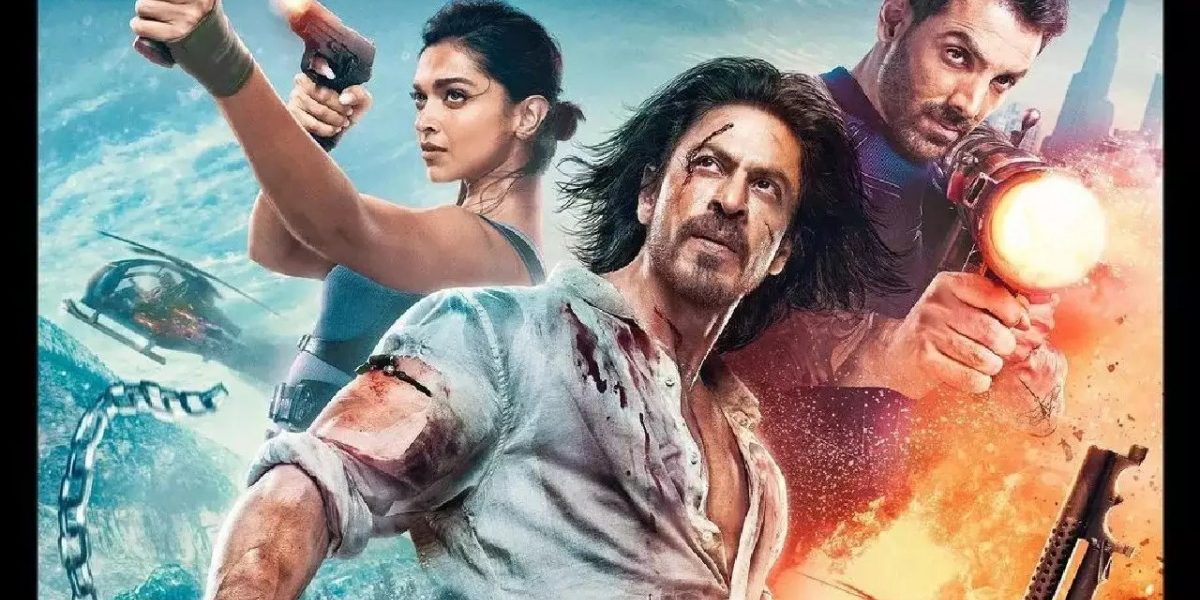Even the most ardent Shahrukh Khan fan will concede that his last decade was far from satisfactory. For someone largely immune to the star’s charms, I thought that period was disastrous. I don’t need to say anything more; the films do the talking: Ra.One (2011), Don 2 (2011), Happy New Year (2014), Dilwale (2015), and Jab Harry Met Sejal (2017) were not just shoddy movies but filmmaking embarrassments.
These failures seemed even more disconcerting because Khan, well into his 50s, could no longer use his romantic shtick. Worse, a series of big Bollywood flops over the last year shook and shocked the industry. So Siddharth Anand’s Pathaan rolls two anticipations in one, both comebacks: Khan’s big screen appearance after four years and Bollywood’s chance to reassure its audiences that it can still entertain. So much is at stake here that the 146-minute movie seems like a singing hashtag: #NoPressure.
So it almost feels like an inside joke when an early scene features Pathaan (Khan), a retired RAW agent, telling his senior (Dimple Kapadia) about Kintsugi, the Japanese art of repairing broken pottery. Because there’s a comeback within this story, too: Pathaan launching a covert mission with a few “broken soldiers” to hunt a new feared terrorist, Jim (John Abraham), who, like him, was a RAW agent.
Pathaan takes some time to find the meat of the story. Till then, it gives its audiences their star: Khan, like a vintage hero, living more than once – now an action hero. Fistfights over speeding trucks, a car chase, a helicopter stunt – it’s all in there. The action sequences are sharp and slick, keeping you in the story. And if people had any misgivings about their leading man, then Khan assuages them all. After a long time, Pathaan gave me the feeling that Khan was directing himself. Because he doesn’t do a lot here – he isn’t trying to be something; he just is. Whether it’s the blazing action set-pieces or his flirtatious conversations with Deepika Padukone’s character (an ISI agent, Rubina Mohsin), Khan – in this charged espionage drama that sporadically resembles a heist film – is a portrait of impressive restraint.
Even the supporting actors, such as Kapadia and Padukone, shine. Unlike many star vehicles, Pathaan doesn’t make them rally around but with Khan. The most surprising element though is Abraham. He starts off with a homage to Dhoom – “in a different life, we might have been friends” – and then nails Pathaan’s tone and tenor: that it’s a simple mainstream entertainer. Simple, however, doesn’t mean superficial or lazy. His Jim has all the qualities of a good villain: he’s credible, cruel, funny – and springs surprises with ease.
The last quality percolates to the film as well. Pathaan is busy and purposeful. Anand never lets his story drag, infusing enough surprises that stay true to the movie. Like Khan, the filmmaker keeps a tight control over his excesses. You won’t find superfluous songs or other narrative paddings, signalling star wattage. That’s so because Anand is confident with what he has: a fascinating take on the well-trodden espionage genre. I don’t need to tell you how most Bollywood directors treat their films the moment “national security” is involved. Anand isn’t so burdened. He’s assured enough to show us an ISI agent who isn’t Evil. There are no booming dialogues on deshbhakti or Pakistan-bashing. Jim is, in fact, originally Indian – someone who later says he doesn’t belong to any country. A “terrorist without a country”? You don’t see such films every Friday.
Also read: By Tackling What Cannot Be Said, ‘Trial by Fire’ Emerges a Show of Stirring Merits
But it’s not as if Pathaan is flawless. In stretches it buys into the espionage genre a bit too hard: It introduces a twist, then injects another twist cancelling the first, and so on. Its sharp spies contradict their intelligence to make the plot race forward. Rubina, for instance, tells Pathaan about Jim’s main plan. He listens to her and just… agrees. (He regrets it later.) Later in the movie, his gullibility recurs. Pathaan, now distrusting Rubina, again listens to her version and just… agrees. Padukone is magnetic on screen, but her character demanded more thought and finesse. At times, the writing falls into an explanatory mode: a protagonist, a pathos-ridden flashback; another protagonist, another pathos-ridd… you get the idea.
More crucially, for a movie that talks about Kintsugi, Pathaan doesn’t own its scars – or tries too hard to be perfect, sometimes to its own detriment. Just take a look at its action sequences: everything is matched, coordinated, choreographed. There’s nothing inherently wrong with such an approach – and the set pieces are visually arresting – but after a point, they lack the ability to surprise. The settings just look like passive pretty things. Anand does break the pattern once – in a bike chase sequence on frozen water – but a thriller like this needed more such dynamism.
The overall feeling, however, I got while exiting the theatre was not something I’m ordinarily used to. Here was a Bollywood ‘mass-ey’ movie that told its story in a dramatic register without insulting my intelligence or scoring cheap political points or using its star as a crutch. A lot of credit rests with Khan himself. He leads like a captain, moves like a cool cat, bites like a ravaged predator, and charms like a veteran. The 57-year-old ‘thirst trap’ himself looks thirsty for artistic credence. And his audiences, like him, have waited for long. Now that wait is over, and both the well and the parched can’t stay still.
This article was first published on The Wire.

